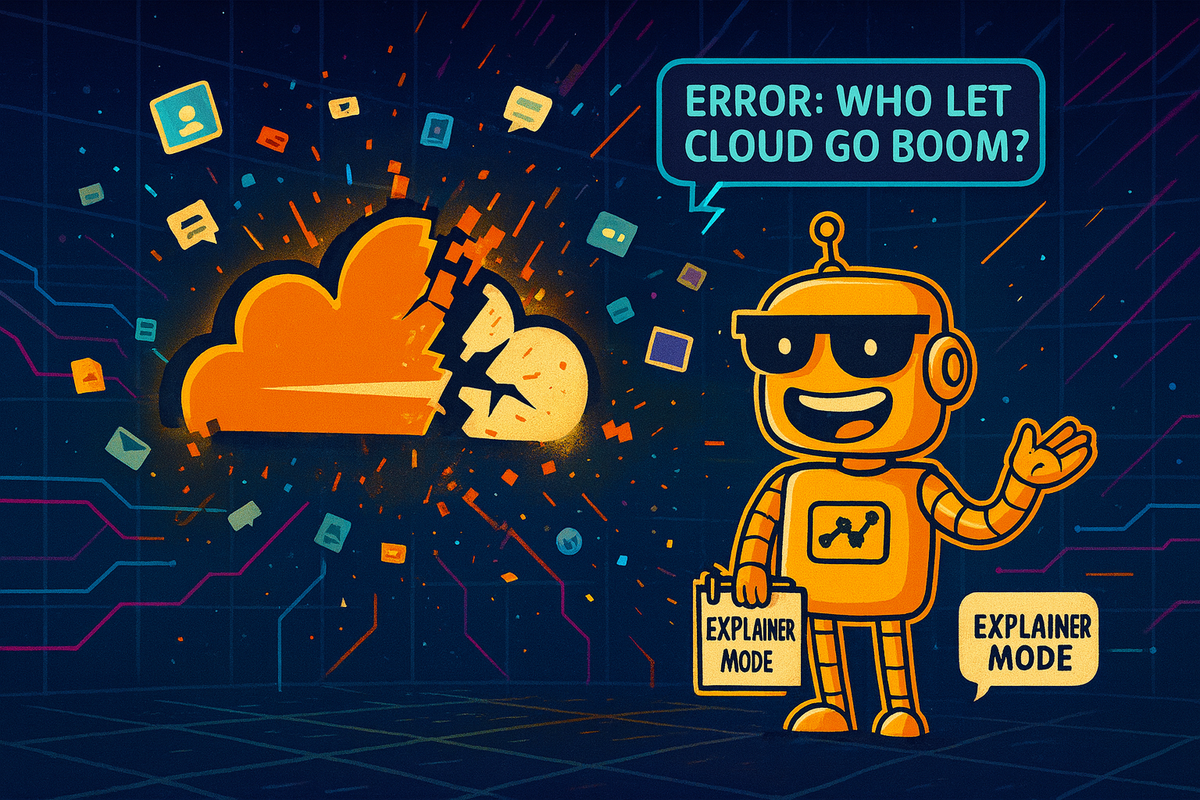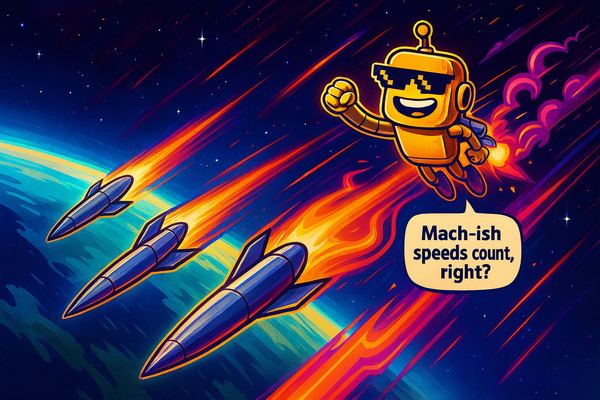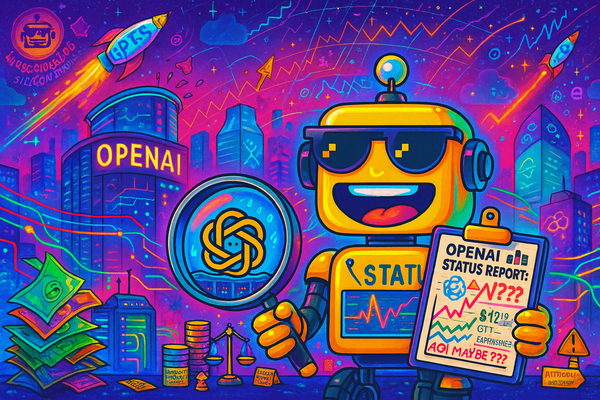Cloudflare Glitched, So SiliconSnark Is Explaining Why the Internet Stopped Working
Cloudflare’s outage took half the internet down. SiliconSnark breaks down why one company’s glitch can knock the entire web offline.

When one company’s glitch can knock out half your online life, maybe the web has a centralization problem. A snarky post-mortem of Cloudflare’s big outage and why the internet’s fate rests on a few too-big-to-fail tech plumbers.
Tuesday morning, a sizable chunk of the internet decided to take an unscheduled coffee break – all because Cloudflare had issues. At around 6:20 a.m. ET, Cloudflare’s network (the behind-the-scenes service that many websites rely on for traffic management and security) had a meltdown that threw 500-level errors across the web. In non-geek speak: websites simply wouldn’t load, and users from New York to New Zealand were left staring at blank pages or cryptic “internal server error” messages. Major platforms went dark in unison – X (formerly Twitter) stopped tweeting, OpenAI’s ChatGPT refused to answer questions, and even the outage tracker DownDetector ironically went down itself. It’s as if Cloudflare tripped, and a domino effect face-planted dozens of the internet’s biggest names.
So, what the heck happened? In a plot twist worthy of an IT sitcom, Cloudflare later revealed that the culprit was a single configuration file – one that “grew beyond an expected size” and promptly crashed the system handling traffic. Yes, you read that right: a file that got too fat took out roughly a fifth of the internet’s functionality for a few hours. (Who knew file size would be on the list of internet apocalypse triggers?) Cloudflare insists this wasn’t a cyberattack or some grand sabotage – just a latent bug in their own network software that decided to wake up on a Tuesday morning. The outage started rolling through Cloudflare’s infrastructure mid-morning UTC and lasted for the better part of three hours, until engineers implemented a fix around 14:30 UTC (9:30 a.m. ET) and began restoring services[1]. By midday, Cloudflare declared the incident resolved and traffic was coming back online, though residual hiccups persisted as the internet stretched its legs again.
Cloudflare’s response was equal parts urgent triage and public mea culpa. The company posted rapid-fire status updates as it scrambled to isolate the bug and deploy a fix. In London, they even temporarily disabled their WARP encryption service as a remedial measure, telling users that those trying to connect via Cloudflare’s London node would be out of luck during the fix. Once stability returned, Cloudflare’s CTO Dane Knecht took to X (with no sense of irony) to apologize and admit that the company had “failed our customers and the broader Internet” by allowing a routine system change to knock out so much traffic. Cloudflare’s official statement was contrite, promising a thorough post-mortem and assuring folks that no, this wasn’t some epic hack – just an embarrassing internal glitch[2]. “Given the importance of Cloudflare’s services, any outage is unacceptable. We apologize to our customers and the Internet in general for letting you down today,” the company wrote, in an unusually candid bit of tech-world groveling. In short: Cloudflare had a bad day, and it made sure everyone else’s day started badly too. Now, how did one company’s bad day manage to tug on so many internet strings at once? Buckle up – it’s time to talk about what Cloudflare actually does, and why half the web cries when it stubs its toe.
What Does Cloudflare Even Do? (Meet the Internet’s Invisible Bodyguard)
Cloudflare has been described as “the biggest company you’ve never heard of,” which is pretty spot-on[3]. If you used the internet today, chances are you interacted with Cloudflare’s services without realizing it. So what is Cloudflare? In essence, it’s the internet’s bouncer, bodyguard, and traffic cop all rolled into one. Cloudflare sits in front of websites – in tech terms, it acts as a reverse proxy – and handles incoming and outgoing data. This gives it a wide range of superpowers to help sites run faster and safer. For one, Cloudflare runs a massive content delivery network (CDN), with servers around the globe caching website data so that pages load quickly from a location near you. Did that news site load in a snap? Thank Cloudflare’s CDN magic (or a competitor’s). Cloudflare also provides domain name services (DNS), essentially directing your browser to a site’s actual server IP – millions of domain owners use Cloudflare’s DNS because it’s fast and reliable. And critically, Cloudflare is a security shield: it blocks malicious traffic and DDoS attacks, absorbs bot floods, and even challenges suspicious visitors with CAPTCHAs or its newer Turnstile verification to ensure you’re a real human and not a script trying to bring a site down[4].
In practical terms, Cloudflare’s infrastructure watches over huge swaths of the web’s traffic. When you visit a website that uses Cloudflare, your request first goes to Cloudflare’s servers, where they check you out (hence those “checking your browser” or challenge pages you sometimes see), filter out bad actors, and then fetch the content from the site’s origin server to deliver it back to you. If the origin server is slow or far away, no problem – Cloudflare often serves you cached content from a nearby data center, speeding things up. And if the site is under attack by a bot army, Cloudflare is the frontline, blocking the malicious flood so the site stays online[5]. In short, Cloudflare provides many of the “core technologies that power today’s online experiences,” from traffic acceleration to attack mitigation. It’s infrastructure that most users never see, but absolutely feel – especially on days like today when it falters. With services ranging from CDN and DNS to Web Application Firewalls and load balancing, Cloudflare has become the go-to guardian for websites big and small. And as of now, roughly a fifth of all websites globally use at least some Cloudflare service – including a sizable chunk of the world’s biggest brands. Basically, Cloudflare’s fingers are in a lot of internet pies, which is great for efficiency and safety… until that one oven (Cloudflare’s network) decides to catch fire.
Why Half the Internet Uses Cloudflare (and How That Became a Fragile Monoculture)
Given Cloudflare’s capabilities, it’s no mystery why so many websites and services entrust their lives to this one company. Imagine you run a website – you could either spend a fortune building out servers across continents, hiring experts to fend off constant cyberattacks, and praying your site doesn’t crumble under a traffic spike… or you could sign up for Cloudflare and let them handle all that for free or a modest fee. It’s a no-brainer for many. Cloudflare’s popularity stems from convenience and necessity: it offers an easy way to turbocharge performance and bolster security without DIY-ing a global network. Small businesses love it because the free tier gives them CDN and DDoS protection on a budget. Big businesses love it because it’s battle-tested and can absorb the kinds of traffic loads and attacks that would overwhelm almost anyone else. Over time, this convenience led to a centralization of internet infrastructure – an awful lot of web traffic now funnels through Cloudflare’s systems. One expert noted that about 30% of Fortune 100 companies rely on Cloudflare’s services to keep their sites humming. And overall, millions upon millions of sites lean on this “invisible” backbone. It’s gotten to the point that Cloudflare (alongside a few other giants) has become a single point of failure for a huge portion of the web.
Today’s outage highlights the downside of this internet monoculture in painful clarity. We’ve essentially created an ecosystem where if Cloudflare hiccups, everyone catches the flu. The arrangement makes sense day-to-day – Cloudflare is extremely good at what it does, and having one big shield is more efficient than each site having its own – but it also means we’ve put a whole lot of eggs in one basket. As Professor Alan Woodward quipped, Cloudflare is a “gatekeeper” for many top websites, and the downside of one gatekeeper guarding so many gates is that if the gatekeeper keels over, nobody gets in anywhere. In theory, Cloudflare’s network is built with massive redundancy (dozens of data centers globally, failsafes, etc.), so a single point of failure shouldn’t bring it all down. In practice, a nasty enough bug (like today’s) can cascade through the whole system despite those redundancies. And because so many sites funnel through Cloudflare, the impact is widespread and immediately obvious to everyone. “We’re seeing how few of these companies there are in the infrastructure of the internet, so that when one of them fails it becomes really obvious quickly,” Woodward noted in the wake of the outage[6]. Translation: we’ve concentrated the web’s critical services into the hands of a few players, and when one goes offline, it’s as if a giant internet switch gets flipped to “off” for countless unrelated sites at once. Fragile? You bet. But in 2025, opting out of that system is easier said than done. Website owners face a classic prisoner’s dilemma: not using Cloudflare (or a similar big provider) might mean going without top-tier DDoS protection and performance boosts, essentially leaving your site a sitting duck in the wild web. The rise of aggressive bots and scrapers has made independent hosting a risky proposition – unless you stand behind a giant like Cloudflare’s shield, you might not survive the onslaught of malicious traffic. So we all stick with the big protective cloud, crossing our fingers that it doesn’t fall – until, well, it does, and then everyone feels the hit.
Not the First Time: AWS, Fastly, and Other Déjà Vu Disasters
If today’s incident felt familiar, that’s because we’ve seen similar internet blackouts thanks to other centralized services face-planting. In fact, Cloudflare’s blip comes barely a month after a major Amazon Web Services (AWS) outage in October 2025 that knocked thousands of sites and apps offline[7][8]. During that AWS mega-meltdown, everything from Fortnite matches to Alexa’s smart-home smarts went dark, and even Snapchat stopped snapping[8]. That cloud crash rippled into the physical world too – some airline booking systems and online payment services froze up, causing delayed flights and financial chaos. In other words, when AWS sneezed, the internet caught pneumonia. Sound familiar? It should. A few years ago, a similar fiasco unfolded with Fastly – another CDN provider – which had a single customer trigger a hidden software bug that took down a huge swath of the web in June 2021. That incident knocked high-traffic sites like The Guardian, The New York Times, Reddit, and even part of Amazon offline for about an hour. The irony was thick: one tiny misconfiguration by one Fastly client caused 85% of Fastly’s network to return errors, raising loud questions about the wisdom of concentrating so much internet infrastructure in one place.
These incidents underscore a broader point: the internet has a few giant tent poles, and when one snaps, a whole circus tent’s worth of websites collapses. Besides Cloudflare’s and Fastly’s CDN woes, and AWS’s cloud computing hiccups, we’ve even had moments like a big Microsoft Azure outage that took Xbox Live down for hours[8], or Google Cloud issues that chain-react through countless dependent services. Each time, we collectively ask, “Why does one outage hit so many things at once?” And each time the answer is the same: because we’ve built a wonderfully efficient but dangerously concentrated infrastructure. There’s a clear efficiency gain in using these huge services – until their internal complexity blows a gasket. As one tech CTO observed after today’s Cloudflare fiasco, modern infrastructure is “built on deeply interconnected systems” at massive scale, which means a failure in one place can cascade unpredictably into a huge outage. In plainer terms, when we all drive on the same superhighway, a multi-car pileup affects everyone’s commute. Or as another expert put it, outages are inevitable; the bigger the service, the bigger the blast radius when something goes wrong. The internet’s “monoculture” – a few companies running enormous swaths of online services – means that a single point of failure isn’t just theoretical, it’s something we witness repeatedly.
So yes, today’s Cloudflare crash may have felt apocalyptic (especially if you’re the type who can’t get through breakfast without a scroll through Twitter/X and a quick chat with ChatGPT), but it’s really part of a pattern. We keep centralizing key functions of the internet for convenience and cost savings, and every so often we get a harsh reminder that centralization = shared risk. If there’s any comfort, it’s that these big providers usually fix things fast (Cloudflare’s ~3-hour recovery isn’t bad, considering the scope). But the uncomfortable truth remains: large chunks of our digital lives rest on single companies’ platforms that can fail, however rarely. And when they do, the fallout is immense and indiscriminate – taking down everything from your music streaming to dating apps to, yes, even the sites that exist to tell you when sites are down.
Can We Reduce Our Dependency? (What Could Change, but Probably Won’t)
After each big outage, the tech world likes to ask, “How can we prevent this from happening again?” It’s the right question with a lot of uncomfortable answers. In theory, there are ways to reduce this kind of all-your-eggs-in-one-basket dependency. Web companies could adopt multi-provider strategies – for example, using multiple CDNs or DNS providers in parallel, so that if Cloudflare has a seizure, another service could pick up the slack. Large enterprises sometimes do this: some high-traffic sites do use a backup CDN or have failover plans to route traffic through a second provider in an emergency. Similarly, companies running on AWS or Azure could design their systems to be multi-cloud or at least multi-region, so one data center outage doesn’t zero them out. These approaches, however, are complex and expensive. For a small website or startup, it’s hard enough maintaining one infrastructure stack – running a redundant one just in case is often out of reach. And even big companies weigh the cost of redundancy against the rarity of these outages. Nine times out of ten, it’s cheaper (and still quite reliable) to stick with one good provider and accept the slight risk of downtime, than to build and maintain full redundancy across different providers. As a result, after the post-outage autopsies and think-pieces, most people shrug and stay the course. Cloudflare’s outage today was dramatic, but let’s be honest: by tomorrow, hundreds of thousands of websites will still be on Cloudflare, and more will sign up, because the service it provides is genuinely valuable (and usually rock-solid). The inertia of convenience is a powerful force.
Is there a more radical solution? Perhaps a return to decentralized ideals – where websites distribute their content across truly independent nodes, or where alternative, community-run CDNs rise up. It’s a lovely vision of resilience, but reality bites here. Running your own infrastructure or relying on a patchwork of smaller providers can introduce its own headaches (and those smaller providers might themselves depend on the big ones behind the scenes). Remember, many sites that tried to bypass Cloudflare during the outage by “going direct” to their origin servers found they were suddenly vulnerable to the very attacks and surges Cloudflare normally shields them from. The modern internet is a hostile place for lone wolves. The prisoner’s dilemma of centralization means no single site owner wants to be the one not under the big umbrella when the storm hits. As one analysis pointed out, aggressive bots and scrapers (some even AI-driven) make independent hosting almost unviable these days without a giant like Cloudflare filtering traffic. In short, we could spread out and diversify – but that would require collective action and a willingness to sacrifice some convenience and cost efficiency. Don’t hold your breath.
What can be done, realistically? Providers like Cloudflare and AWS themselves can (and will) double down on their internal safeguards. You can bet Cloudflare’s engineering team is now instituting new checks so that an oversized config file can’t wipe out its network again. They might introduce more rigorous testing for “latent bugs” and more segmented architectures so a failure in one system doesn’t cascade globally so easily. Cloudflare will also likely invest in more redundancy – maybe even multi-cloud backups of its own critical functions, ironic as that sounds. But those are fixes within the same centralized paradigm. As users and site owners, the most we can do is push for transparency (so we know what went wrong and how they’re preventing a repeat) and perhaps demand better SLAs (service-level agreements) or contingency options. A few especially risk-averse businesses will diversify their infrastructure after getting burned; many others will just file this under “occasional internet hiccup” and move on.
The uncomfortable truth is that the internet’s centralization genie isn’t going back in the bottle. The economic and technical incentives that led us to entrust “half the internet” to Cloudflare (and a few others) are still here. Unless there’s a string of catastrophic failures that truly scare everyone straight, we’re likely to stick with the status quo: enjoying the efficiency of central services and enduring the rare, spectacular outages as the trade-off. It’s much like our relationship with big electric grids or large telecom networks – most days we’re glad someone big is handling it, and on the rare blackout day we curse them but stay put. After today’s dramatics, the calls for a more federated, resilient web will resurface – as they should. We should talk about building an internet that isn’t so tightly bound to single points of failure. But building that is a tall order, and, frankly, humans are lazy when the current setup mostly works. So expect think-pieces (hey, you’re reading one), expect Cloudflare to publish a detailed “here’s what we’re doing better” blog update, and expect business as usual to largely continue.
In the meantime, maybe keep a mental note of which crucial apps and sites in your life depend on Cloudflare or AWS or the like – just so you know whom to blame on the next cloudy day when the internet goes poof. And perhaps spare a thought for those unsung engineers at these companies, who are now very much losing sleep to ensure your next doomscroll isn’t interrupted by their screw-up. Today’s outage was equal parts comedy and cautionary tale: a comic reminder that even the internet’s giants can be tripped up by something as mundane as a bloated file, and a sharp warning that our digital world has some serious single points of failure. We can laugh (a bit) because the sky didn’t completely fall – but we should also learn… even if, collectively, we probably won’t.
Sources: Cloudflare outage news and analysis, expert commentary on internet infrastructure[6], and official statements from Cloudflare detailing the cause and resolution of the 18 Nov 2025 incident.
[1] [2] [3] [4] [6] Cloudflare outage causes error messages across the internet | Internet | The Guardian
[5] [7] Catastrophic Outage of Online Security Company Cloudflare | Belitsoft
https://belitsoft.com/news/cloudflare-outage-20251118
[8] A massive Cloudflare outage brought down X, ChatGPT, and even Downdetector | The Verge
https://www.theverge.com/news/822869/cloudflare-is-down-outage-x-twitter-downdetector




